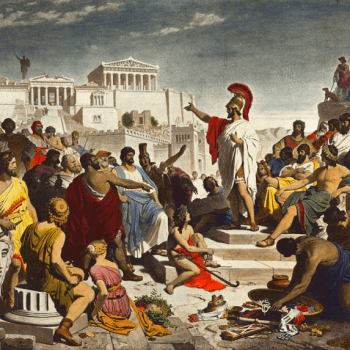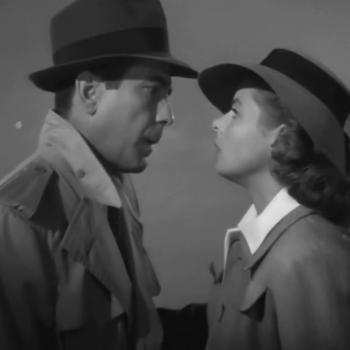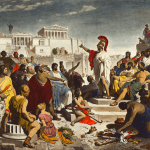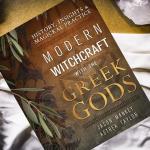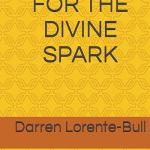We’ve previously been over why fascism is bad and why white nationalism is an ignorant idea. So I’m not going to repeat those deconstructions here.
But I will repeat this: white nationalists are disinvited from my home, my office, my dojo, or any event I host or coordinate. I respect the right of free speech, but I also believe self and community defense is both a right and a duty and will use any means necessary to stop any white supremacist violence.
So: Charlottesville.
Statues of anti-American pro-slavery Confederate terrorists should have been melted down and recycled into toilet bowls a long time ago.
Nazis suck.
Nazi murderers who crash cars into crowds of people need to be removed from society. My deepest condolences and blessings go to the family of Heather Heyer, and to those injured and their families.
Fascists in polo shirts with tiki torches and cosplay shields are truly pathetic. But that’s kind of the appeal of fascism: pathetic people get to feel like they’re part of something big. The photos from this weekend lend a new vibrancy to the Dead Kennedy’s lyric from “Nazi Punks F**k Off” : “In a real Fourth Reich, you’ll be the first to go.”
It is just and right to laugh at them, to condemn them, to peacefully counter-protest their events; and if faced with violence, to use necessary force in self-defense.
I doubt any of you, dear readers, needed me to tell you these things, but just in case there’s any question, in case these words should reach someone who isn’t clear on these matters, there you go.
Now what?
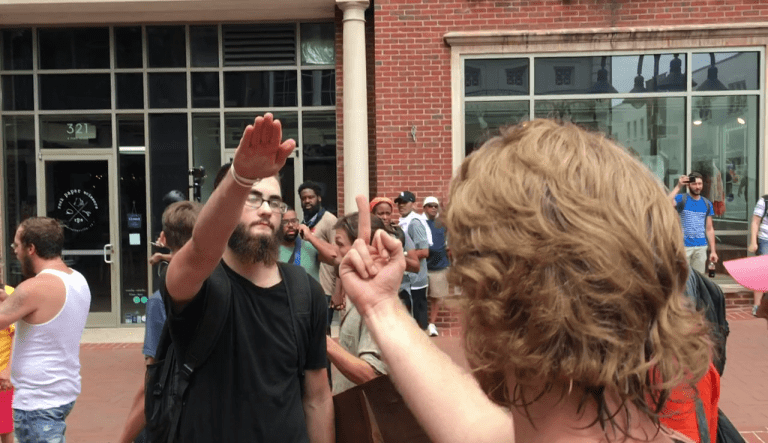
No Excuses, But Causes
There is no easy good response here. Our problem with racism goes back to the European invasion of 1492, and the resurgence of fascism is tied to social and economic factors that have been at play since first Reaganomics and then neoliberal economics started hollowing out the working and middle classes.
Of course, in a sense racism is rooted in economics — Columbus and his compatriots came here for gold, and “whiteness” was invented in the 1690s as a means to keep workers of Europeans ancestry from joining up with those of African ancestry to overthrow the ruling class elite.
But there’s a more direct and recent relationship between fascism and economics. It was the Great Depression that spawned fascism to Germany and Italy, and it was quite popular here in the US for a while in the 1930s. Economic distress isn’t the only factor but it makes an excellent breeding ground for nationalistic, us-versus-them scapegoating.
Our current situation is far from the Depression, but research by Shannon Monnat of Penn State found that Trump did the best compared to Romney in counties with the highest drug, alcohol, and suicide mortality rates, and that much of the relationship is accounted for by economic distress.
There is a vein of despair out there. The differences in mortality are not small; the rate of youth suicide in rural communities is twice what it is in urban areas, and some Trump-swinging counties have an overdose death rate 36% higher than the national average.
And these factors matter to white supremacist recruitment. A study of the life histories of white supremacists by researchers at the University of Nebraska at Omaha found that:
- 72% had substance use disorders,
- 62% had either attempted suicide or seriously considered it,
- 57% had mental health problems either before or during their time in extremist groups,
- 54% had either dropped out or been expelled from school,
- 45% had been physically abused,
- 46% were neglected as children,
- 21% had sexually abused
All of these experiences are going to be more common in economically distressed communities. That’s not to say that these groups draw exclusively from such communities, or only from people with troubled backgrounds, but the numbers here speak for themselves.
This is not a justification or an excuse. Let me say that again: this is not a justification or an excuse. Nor is it to deny that things are awful in poor urban African-American communities. That awfulness erupts in a different way — as we see, for example, in Baltimore’s record high murder rate.
But if we understand that economic factors make people more vulnerable to falling under the sway of white nationalist ideologies, it suggests a solution: rebuild the working and middle classes. Conveniently, that solution also helps African-American communities.
Obviously that’s not an overnight solution. In the meanwhile perhaps we can push this leftist, populist, anti-racist message: “The 1% has been destroying the middle and working classes for decades. If you’re mad at black people, Jewish people, Latino people, or Muslim people over it, you’re being played.”
We should also note that murderers typically have a history of violence. Heather Heyer’s murderer was not an exception. There were at least four 911 calls about his violent and erratic behavior, and police had been to his home nine times.
We don’t need more speech laws or more gun laws to stop people like this from killing. We need to take these early acts of violence seriously. But again, criminal justice and mental health care reform are not quick fixes.
Bad Responses
There are no good quick fixes. There are, as usual, some bad quick fixes being suggested. Some people are calling for more restrictions on the rights of free speech and assembly. Others are calling for, or preparing for, more violent and aggressive direct action — vigilante violence against fascist speech.
Frankly, that anyone would call for more government restrictions on free expression while Donald Trump is in the White House leaves me astounded. We don’t need any new laws to lock up Heather Heyer’s murderer, and any such laws are certain to be turned against progressive causes.
Legal blogger Ken “Popehat” White recently pointed out that we’re at the end of two classic hypotheticals about restricting so-called “hate speech”: “But what if Nazis march?” and “But what if really bad people control the government?”
The First Amendment unquestionably and broadly protects what we call “hate speech.” If you point that out, you get hypotheticals in return. “Really? So, the day that Nazis march the streets, armed, carrying the swastika flag, sieg-heiling, calling out abuse of Jews and blacks, some of their number assaulting and even killing people, you’ll still defend their right to speak?”…
We free speech defenders are just as quick with hypotheticals; it’s built into our worldview. “Really? So you’d give the state the power to choose what speech is acceptable and what speech isn’t, and use its vast power to punish the difference? You’re comfortable giving it that power, even though some day that state might be controlled by an implacable enemy of everything you believe in, a tyrant who overtly relishes the power to punish people who think like you do, encouraged by supporters who hate you?”…
Our present circumstances show why it is sheer terrified madness to entrust a broad power to prevent or punish speech upon a fickle state. We’ve flirted with that madness of abandoning rights in pursuit of safety for our nation’s whole life. The flirtation has turned sordid and degrading during the War on Crime and frankly self-destructive after 9/11. It would be philosophical suicide to hasten it now by giving a government — a visibly terrible and amoral government — the power to regulate speech. This is the final hypothetical come to pass: if the state asked you to give up freedoms in exchange for a dubious promise it would make you safer, would you do it? Would you convince yourself that the state would only use the power against Them, and not you?
Giving the Devil Benefit of the Law
We don’t protect the rights of Nazi fools and fascist idiots for their benefit. We do so for our own, recognizing that when we create institutions to police wicked thoughts, however good our intentions the thought police are inevitably going to get out of control.
I’ve been thinking much lately of an exchange from the film A Man For All Seasons, about the life of Sir Thomas More:
William Roper: So, now you give the Devil the benefit of law!
Sir Thomas More: Yes! What would you do? Cut a great road through the law to get after the Devil?
Roper: Yes, I’d cut down every law in England to do that!
More: Oh? And when the last law was down, and the Devil turned round on you, where would you hide, Roper, the laws all being flat? This country is planted thick with laws, from coast to coast. Man’s laws, not God’s! And if you cut them down — and you’re just the man to do it — do you really think you could stand upright in the winds that would blow then? Yes, I’d give the Devil benefit of law, for my own safety’s sake!
It is not a hypothetical that our government will misuse any power we give it to restrict speech. The federal government sentenced Eugene Debs to a decade in prison for speaking out against World War I. Alabama threw Martin Luther King in the Birmingham jail for violating an injunction against against marching or demonstrating.
It took less than seventy-two hours for New York governor Andrew Cuomo to try to get political advantage from the aftermath of Charlottesville by adding what he’s calling “Charlottesville provisions” to the state’s hate crime law. Defense attorney Kenneth Perry, who has represented dozens of Black Lives Matter protesters, calls the proposal “reactionary”, explaining “it becomes coercive. The state already has so much power. The balance is already so skewed as it is.”
Civil rights attorney Normal Siegel points out that the purpose of hate crime laws was to deter discrimination: “It hasn’t worked…If it worked, why would we have Charlottesville? It just increases penalties and makes the bigots martyrs.”
And that, keep in mind, is in deep blue New York. Think of how such laws would be abused in Texas or Mississippi.
Fighting Fire With Fire
So some, despairing of state action’s ability to reign in vile speech, are prepared to take matters into their own hands.
Now, I stand foursquare for the right to self and community defense. When I teach self-defense, I start with the premise that it is the most basic human right. I own guns and am prepared to use them to protect myself, my household, or my community. And I’ve been recommending for a while now that people read Charles E. Cobb’s This Nonviolent Stuff’ll Get You Killed to understand the role that armed defense played in the civil rights movement.
But to initiate violence against someone based on their words or ideas — however vile, however wrong, however provocative, however disgustingly evil — is both a tactical and a spiritual error.
In the wake of Trumps’ election we’ve seen a number of minor but significant incidents of assault in the name of direct “anti-fascist” action. There was the famous punching of wingnut Richard Spencer, and the pepper spray attack on a woman wearing what looked like — but wasn’t — a Trump “Make America Great Again” hat.
There was also the shooting of Representative Steve Scalise, Capitol Police Crystal Griner, Congressional aide Zack Barth, and lobbyist Matt Mika by James Hodgkinson, a man who had expressed center-left views and support for Bernie Sanders. The degree to which that was political violence versus a manifestation of personal demons remains unclear.
In Charlottesville, counter-protesters punched one reporter — not a Nazi, a respectable reporter — and doused others in raw sewage and threatened at least one with a firearm. A counter-protester was seen hurling a newspaper box at white nationalist marchers; others attacked marchers with sticks.
There was potential for things to go much further. About 20 members of armed leftist group Redneck Revolt were open carrying rifles at Charlottesville.
Of course this was only a fraction of the counter-protesters in Charlottesville, and their violence pales in comparison to vehicular homicide! Let me say that again: while both are wrong, there is not a moral equivalence here between punching someone and running a car into a crowd of people. We can speak out against two different things without saying they’re the same.
(“War is bad! Also, when you go to an anti-war march, you shouldn’t litter.” “Are you saying there is a moral equivalence between war and littering?!” Because this criticizing without equivalizing seems to be hard for some people to understand, I put together the chart below.)
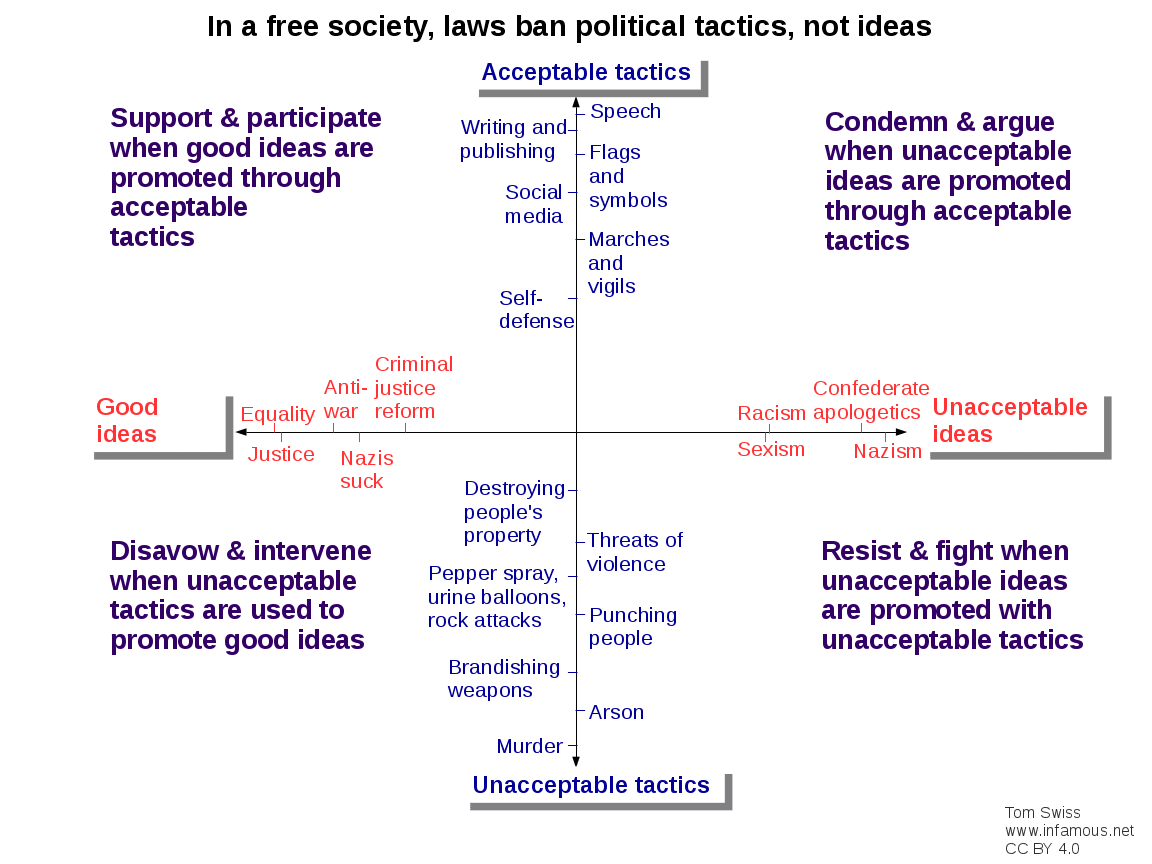 And if I’m devoting more words to criticizing violent counter-protesters than to denouncing Nazi scumbags, it’s because anyone reading this almost certainly knows that Nazi scumbags are bad, while a number of my friends think that vigilante attacks on Nazi scumbags are a good idea.
And if I’m devoting more words to criticizing violent counter-protesters than to denouncing Nazi scumbags, it’s because anyone reading this almost certainly knows that Nazi scumbags are bad, while a number of my friends think that vigilante attacks on Nazi scumbags are a good idea.
The narrative that “all the violence in Charlottesville came from white supremacists, only they showed up armed” that’s being widely spread is not accurate. Denial of facts never helps our cause.
There are a significant number of people on the left ready to fight fire with fire. Funny thing about that: every firefighter I’ve known used water.
(But it is interesting that armed groups on both sides, the rightist militia who said they were there just to protect free speech and the leftist militants who claimed to focus on maintaining a defensive perimeter, seem to have behaved themselves. Military discipline is a thing. Though I still think open carry of long guns at a demonstration is at the very least rude. Put that thing in a case.)
Bad Tactics
It’s a counterproductive tactic to make martyrs out of fascists. Back in March 2016, I pointed out that efforts by “shutdown culture” — “deplatforming” seems to be the currently fashionable term — to silence Trump and his supporters were actually increasing his support. They likely played a role in giving him the presidency.
Using aggressive violence against these people helps their recruitment. Their whole spiel is that good people — exclusively white people — are under threat by a coalition of black people, brown people, Jews, Muslims, and “race traitors.” Any photo they can show of one of us beating one of them is a recruitment poster, it strengthens their case that “law and order” are breaking down and that “decent” people must band together with them.
Of course informed citizens like you and I see through that, but placing your hopes on the information level of the average citizen is at best a risky bet.
This was the tactical brilliance of the nonviolence of the civil rights movement — even as they worked with groups carrying out armed defense. (For example, organizers from the nonviolent Congress of Racial Equality (CORE) helped found the famous Deacons for Defense and Justice. (Cobb, 192-193)) At large protests, nonviolent tactics neutralized any argument that they were a violent mob undercutting civil order; while at the same time, in a story that hasn’t been told much, armed black men and women engaged in purely defensive action to protect their homes and communities against clear-cut aggression.
Using aggressive violence can also make it less likely that people leave extremist groups. Sociologist Pete Simi, who has extensively studied white supremacists, notes that:
Part of the problem is that formers [former members of extremist groups] may also be verbally or physically confronted by violent anti-racists who may think this person is fair game. So I think we have to ask ourselves whether what we’re doing is making it harder for people to leave these groups and, if so, I think we should revise our approach.
And introducing offensive violence into the situation clouds the legal issues when white supremacists use violence. Deandre Harris was injured by white nationalist demonstrators in Charlottesville, and has become something of a cause celebre. There are photos and video of him being beaten, and it seems like it should be an open-and-shut case once the men are identified.
But video has surfaced of the minutes before, showing a group of black counter-protesters following the white nationalist demonstrators after police dispersed the demonstration. (If you hit the link, ignore the title and comments.) The counter-protesters challenge the demonstrators to fight (“Come on, do something!”) and at least one of them displays a club.
It’s impossible, in that video, to tell whether Harris was part of that group, or who first attacked whom. But the fact of weapons and aggressive behavior on both sides raises reasonable doubt as to what happened, and could let the men who beat Harris get away.
Finally, some hangers-on in the “alt-right” seem to be not so much white supremacists as bullies willing to use white supremacist imagery to get a rise out of people. I don’t mean to say that’s a lesser sin; if you deliberately march alongside people carrying Nazi flags just to offend people, you deserve to be called a Nazi. But to to win, we must understand the enemy. If we are provoked to angry violence, we give these assholes just what they want.
Aggressive Violence is Corrosive to the Spirit
This is supposed to be a blog about Zen and Paganism, so perhaps I ought to bring matters of the spirit in here.
As a martial artist, violence is my koan, the unsolvable riddle upon which I meditate. One of the most famous koans envisions a man hanging by his teeth from a high tree limb when someone asks him about the meaning of Zen. If he opens his mouth, he falls and dies. If he remains silent, he fails in his duty (and, in some versions, will be killed for it). No way out.
I’ve already opened my mouth. So, as I fall, some thoughts.
If we attack others in anger — even if that anger is provoked by vile words, even if it is a response to hatred, to ideologies that are thoroughly evil — we damage our own heart a little in the process. Buddhaghosa, a fifth-century Buddhist, famously wrote that “By [getting angry] you are like a man who wants to hit another and picks up a burning ember or excrement in his hand and so first burns himself or makes himself stink.” (This is often misattributed to the Buddha himself.)
Pete Seeger put it very well when he wrote, in “Letter To Eve”, “If you want to have great love, you’re gotta have great anger…when I see innocent folks shot down, should I just shake my head and frown?” Does that contradict Buddhaghosa? But Seeger continued, “If you want to hit the target square, you better not have blind anger…or else it’ll be just one more time the correction creates another crime.” So maybe there is a subtle discrimination to be made here.
Buddhism assigns important deities to proper function of anger — the “wrathful deities”. The foremost such deity in Zen, and perhaps in Japanese Buddhism is general, is Fudō-myōō, the Immovable Wisdom King known in Sanskrit as Ācala.
Wreathed in flame, fearsomely fanged, bearing a demon-subduing sword and a rope to bind demons (or, in one account, to lasso the damned out of hell), Fudō-myōō directs the energy of our anger along the path of salvation.
Gary Snyder invoked him in his powerful poem “Spel Against Demons”:
…
Down with demonic killers who mouth revolutionary
slogans and muddy the flow of change, may they be
Bound by the Noose, and Instructed by the Diamond
Sword of ACHALA, the Immovable, Lord of Wisdom, Lord
of Heat, who is squint-eyed and whose face is terrible
with bare fangs, who wears on his crown a garland of
severed heads, clad in a tiger skin, he who turns
Wrath to Purified Accomplishment,whose powers are of lava,
of magma, of deep rock strata, of gunpowder,
and the Sun.
When we stand in defense of others, our face may be squint-eyed and terrible. But to know if we are doing right, we must look to our heart. Is it full of aggressive wrath against those whom we fight? Or is it resting in the purified accomplishment of love, love for those behind us whom we protect but also, impossibly, contradictorily, love for those whom we fight?








